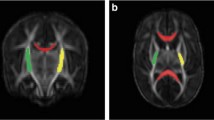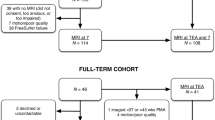Abstract
The unfavorable impact of prematurity on the developing cerebellum was recently recognized, but the outcome after impaired cerebellar development as a prematurity-related complication is hitherto not adequately documented. Therefore we compared 31 preterm patients with disrupted cerebellar development to a control group of 31 gender and gestational age matched premature infants with normal cerebellar development. Supratentorial brain injuries during the neonatal period were comparable between the groups. At a minimum age of 24 months motor and mental development was assessed by standardized tests. Disrupted cerebellar development was associated with significantly poorer scores both in the subtests for neuromotor (p < 0.001) and mental development (p < 0.001), respectively. Mixed CP was diagnosed in 48% of affected patients, whereas none of the patients of the control group had mixed CP. Microcephaly and epilepsy were significantly related to disrupted cerebellar development. Preterm patients with disrupted cerebellar development exhibit poorer outcome results in all investigated variables. The role of the cerebellum in neurodevelopment after prematurity seems to be underestimated so far.

Similar content being viewed by others
References
Allin M, Matsumoto H, Santhouse AM, Nosarti C, AlAsady MH, Stewart AL, Rifkin L, Murray RM (2001) Cognitive and motor function and the size of the cerebellum in adolescents born very pre-term. Brain 124:60–66
Amiel-Tison C, Stewart A (1989) Follow up studies during the first five years of life: a pervasive assessment of neurological function. Arch Dis Childhood 64:496–502
Amiel-Tison C, Gosselin J, Infante-Rivard C (2002) Head growth and cranial assessment at neurological examination in infancy. Dev Med Child Neurol 44:643–648
Argyropoulou MI, Xydis V, Drougia A, Argyropoulou PI, Tzoufi M, Bassounas A, Andronikou S, Efremidis SC (2003) MRI measurements of the pons and cerebellum in children born preterm; association with the severity of periventricular and perinatal risk factors. Neuroradiology 45:730–734
Baumann CR, Schuknecht B, Lo Russo G, Cossu M, Citterio A, Andermann F, Siegel AM (2006) Seizure outcome after resection of cavernous malformations is better when surrounding hemosiderin-stained brain also is removed. Epilepsia 47:563–566
Bayley N (1993) The Bayley Scales of Infant Development. New York Psychological Corporation, New York, NY
Bloedel JR (2004) Task-dependent role of the cerebellum in motor learning. Prog Brain Res 143:319–329
Bodensteiner JB, Johnsen SD (2004) Cerebellar injury in the extremely premature infant: newly recognized but relatively common outcome. J Child Neurol 19:139–142
Bodensteiner JB, Johnsen SD (2006) Magnetic resonance imaging (MRI) findings in children surviving extremely premature delivery and extremely low birthweight with cerebral palsy. J Child Neurol 21:743–747
Cans C (2000) Surveillance of cerebral palsy in Europe: a collaboration of cerebral palsy surveys and registers. Surveillance of Cerebral Palsy in Europe (SCPE). Dev Med Child Neurol 42:816–824
Cox J, Jackson AP, Bond J, Woods CG (2006) What primary microcephaly can tell us about brain growth. Trends Mol Med 12:358–366
Devor A (2002) The great gate: control of sensory information flow to the cerebellum. Cerebellum 1:27–34
De Vries LS, Van Haastert IL, Rademaker KJ, Koopman C, Groenendaal F (2004) Ultrasound abnormalities preceding cerebral palsy in high-risk preterm infants. J Pediatr 144:815–820
De Vries LS, Eken P, Dubowitz LM (1992) The spectrum of leukomalacia using cranial ultrasound. Behav Brain Res 49:1–6
Ilg W, Golla H, Thier P, Giese MA (2007) Specific influences of cerebellar dysfunctions on gait. Brain 130:786–798
Inder TE, Warfield SK, Wang H, Huppi PS, Volpe JJ (2005) Abnormal cerebral structure is present at term in premature infants. Pediatrics 115:286–294
Johnsen SD, Bodensteiner JB, Lotze TE (2005) Frequency and nature of cerebellar injury in the extremely premature survivor with cerebral palsy. J Child Neurol 20:60–64
Kraemer DL, Awad IA (1994) Vascular malformations and epilepsy: clinical considerations and basic mechanisms. Epilepsia 35:30–43
Krägeloh-Mann I, Toft P, Lunding J, Andresen J, Pryds O, Lou HC (1999) Brain lesions in preterms: origin, consequences and compensation. Acta Paediatr 88:897–908
Levisohn L, Cronin-Golomb A, Schmahmann JD (2000) Neuropsychological consequences of cerebellar tumour resection in children: cerebellar cognitive affective syndrome in a paediatric population. Brain 123:1041–1050
Limperopoulos C, Soul JS, Gauvreau K, Huppi PS, Warfield SK, Bassan H, Robertson RL, Volpe JJ, du Plessis AJ (2005) Late gestation cerebellar growth is rapid and impeded by premature birth. Pediatrics 115:688–695
Limperopoulos C, Bassan H, Gauvreau K, Robertson RL Jr, Sullivan NR, Benson CB, Avery L, Stewart J, Soul JS, Ringer SA, Volpe JJ, duPlessis AJ (2007) Does cerebellar injury in premature infants contribute to the high prevalence of long-term cognitive, learning, and behavioral disability in survivors? Pediatrics 120:584–593
Manto M, Bastian AJ (2007) Cerebellum and the deciphering of motor coding. Cerebellum 6:3–6
Marlow N, Wolke D, Bracewell MA, Samara M; EPICure Study Group (2005) Neurologic and developmental disability at six years of age after extremely preterm birth. N Engl J Med 352:9–19
Mercuri E, He J, Curati WL, Dubowitz LMS, Cowan FM, Bydder GM (1997) Cerebellar infarction and atrophy in infants and children with a history of premature birth. Pediatr Radiol 27:139–143
Messerschmidt A, Brugger PC, Boltshauser E, Zoder G, Sterniste W, Birnbacher R, Prayer D (2005) Disruption of cerebellar development: a potential complication of extreme prematurity. AJNR 26:1659–1667
Mikkola K, Ritari N, Tommiska V, Salokorpi T, Lehtonen L, Tammela O, Pääkkönen L, Olsen P, Korkman M, Fellman V (2005) Neurodevelopmental outcome at 5 years of age of a national cohort of extremely low birth weight infants who were born in 1996–1997. Pediatrics 116:1391–1400
Morton SM, Bastian AJ (2007) Mechanisms of cerebellar gait ataxia. Cerebellum 6:79–86
Nixon PD, Passingham RE (2001) Predicting sensory events. The role of the cerebellum in motor learning. Exp Brain Res 138:251–257
Papile LA, Burstein J, Burstein R, Koffler H (1978) Incidence and evolution of subependymal and intraventricular hemorrhage: a study of infants with birth weights less than 1,500 gm. J Pediatr 92:529–534
Peterson BS, Anderson AW, Ehrenkranz R, Staib LH, Tageldin M, Colson E, Gore JC, Duncan CC, Makuch R, Ment LR (2003) Regional brain volumes and their later neurodevelopmental correlates in term and preterm infants. Pediatrics 111:939–948
Riva D, Giorgi C (2000) The cerebellum contributes to higher functions during development: evidence from a series of children surgically treated for posterior fossa tumours. Brain 123:1051–1061
Saab CY, Willis WD (2003) The cerebellum: organization, functions and its role in nociception. Brain Res Rev 42:85–95
Scott RB, Stoodley CJ, Anslow P, Paul C, Stein JF, Sugden EM, Mitchell CD (2001) Lateralized cognitive deficits in children following cerebellar lesions. Dev Med Child Neurol 43:685–691
Shah DK, Anderson PJ, Carlin JB, Pavlovic M, Howard K, Thompson DK, Warfield SK, Inder TE (2006) Reduction in cerebellar volumes in preterm infants: relationship to white matter injury and neurodevelopment at two years of age. Pediatr Res 60:97–102
Sherlock RL, Anderson PJ, Doyle LW; Victorian Infant Collaborative Study Group (2005) Neurodevelopmental sequelae of intraventricular haemorrhage at 8 years of age in a regional cohort of ELBW/very preterm infants. Early Hum Dev 81:909–916
Srinivasan L, Allsop J, Counsell SJ, Boardman JP, Edwards AD, Rutherford M (2006) Smaller cerebellar volumes in very preterm infants at term-equivalent age are associated with the presence of supratentorial lesions. AJNR 27:573–579
Steinlin M, Imfeld S, Zulauf P, Boltshauser E, Lövblad KO, Ridolfi Lüthy A, Perrig W, Kaufmann F (2003) Neuropsychological long-term sequelae after posterior fossa tumour resection during childhood. Brain 126:1998–2008
Stewart AL, Rifkin L, Amess PN, Kirkbride V, Townsend JP, Miller DH, Lewis SW, Kingsley DP, Moseley IF, Foster O, Murray RM (1999) Brain structure and neurocognitive and behavioural function in adolescents who were born very preterm. Lancet 353:1653–1657
Taylor HG, Klein N, Hack M (2000) School-age consequences of birth weight less than 750 g: a review and update. Dev Neuropsychol 17:289–321
Tommiska V, Heinonen K, Lehtonen L, Renlund M, Saarela T, Tammela O, Virtanen M, Fellman V (2007) No improvement in outcome of nationwide extremely low birth weight infant populations between 1996–1997 and 1999–2000. Pediatrics 119:29–36
van de Bor M, den Ouden L (2004) School performance in adolescents with and without periventricular-intraventricular hemorrhage in the neonatal period. Semin Perinatol 28:295–303
Volpe JJ (2001) Neurology of the newborn, 4th edn. WB Saunders, Philadelphia, PA
Wood NS, Marlow N, Costeloe K, Gibson AT, Wilkinson AR; EPICure Study Group (2000) Neurologic and developmental disability after extremely preterm birth. N Engl J Med 343:378–384
Author information
Authors and Affiliations
Corresponding author
Rights and permissions
About this article
Cite this article
Messerschmidt, A., Fuiko, R., Prayer, D. et al. Disrupted cerebellar development in preterm infants is associated with impaired neurodevelopmental outcome. Eur J Pediatr 167, 1141–1147 (2008). https://doi.org/10.1007/s00431-007-0647-0
Received:
Accepted:
Published:
Issue Date:
DOI: https://doi.org/10.1007/s00431-007-0647-0




